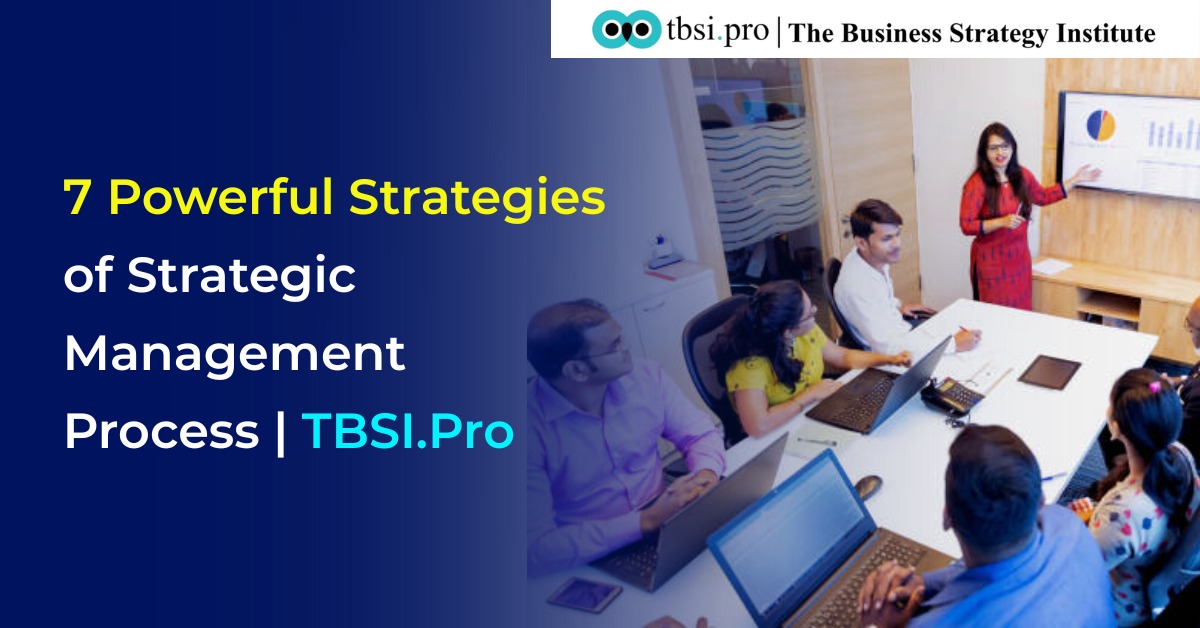
7 Powerful Strategies of Strategic Management Process | TBSI.Pro Introduction to Strategic Management Process
Table of Contents
ToggleIntroduction to Strategic Management Process
In today’s dynamic business environment, organizations must constantly evolve to stay competitive. The strategic management process is a critical framework that enables businesses to set clear objectives, make informed decisions, and achieve sustainable growth. It involves analyzing the internal and external environment, formulating effective strategies, implementing them efficiently, and evaluating outcomes for continuous improvement.
At TBSI.Pro, we guide businesses and professionals in mastering the strategic management process through workshops, training programs, and practical insights. By understanding this process, managers and MBA students can develop the skills to lead organizations effectively and contribute to long-term success.
Importance of Strategic Management
Strategic management is more than just planning—it is about aligning an organization’s resources and capabilities with its environment to achieve competitive advantage. The importance of strategic management lies in several key areas:
- Direction and Focus: It helps organizations define their mission, vision, and objectives clearly.
- Resource Optimization: Ensures resources are allocated efficiently to areas that yield maximum results.
- Risk Management: Identifies potential challenges and prepares contingency plans.
- Performance Improvement: Establishes measurable goals and metrics to track progress.
- Sustainable Growth: Facilitates long-term planning and innovation for continuous development.
Incorporating strategic management ensures that businesses do not operate reactively but proactively, adapting to changes while staying aligned with their core goals.
What is Strategic Management Process?
The strategic management process is a structured approach that organizations use to formulate, implement, and evaluate strategies. It typically consists of the following stages:
- Goal Setting: Establishing clear organizational objectives.
- Environmental Analysis: Assessing internal strengths and weaknesses along with external opportunities and threats.
- Strategy Formulation: Creating actionable plans to achieve organizational goals.
- Strategy Implementation: Allocating resources and executing the strategies.
- Performance Evaluation: Monitoring outcomes and making necessary adjustments.
This cyclical process ensures that organizations remain aligned with their objectives while responding to market dynamics and competitive pressures.
Difference Between Operational and Strategic Management
Understanding the difference between operational and strategic management is crucial for effective decision-making:
| Aspect | Operational Management | Strategic Management |
|---|---|---|
| Focus | Day-to-day activities | Long-term goals and direction |
| Time Horizon | Short-term | Long-term (3–5 years or more) |
| Decision Scope | Routine decisions | High-impact, organization-wide decisions |
| Objective | Efficiency and productivity | Growth, competitive advantage, sustainability |
| Examples | Scheduling, inventory control, workflow optimization | Market expansion, mergers & acquisitions, new product strategy |
While operational management ensures that daily activities run smoothly, strategic management provides the roadmap for where the organization wants to go and how to get there.
Examples of Strategic Management Process
Several organizations illustrate the effectiveness of strategic management:
- Apple Inc.: Uses continuous innovation and market research to stay ahead in technology.
- Amazon: Strategic diversification into e-commerce, cloud computing, and logistics.
- Toyota: Focuses on lean manufacturing and sustainability to maintain efficiency.
- Netflix: Adapts content strategy based on consumer data analytics and global trends.
These examples demonstrate that a structured strategic management process can drive innovation, market leadership, and long-term success.
7 Powerful Strategies of Strategic Management Process
Effective strategic management involves several critical strategies that organizations must adopt to achieve their objectives. Below, we detail the 7 most powerful strategies:
6.1 Clear Goal Setting
Goal setting is the foundation of the strategic management process. It ensures that all organizational efforts are aligned with the company’s vision and mission.
Key actions for effective goal setting:
- Define SMART goals (Specific, Measurable, Achievable, Relevant, Time-bound).
- Communicate goals clearly across departments.
- Align individual and team objectives with organizational priorities.
- Use goal-setting tools to track progress.
Clear goal setting helps employees understand what is expected, motivates performance, and provides a benchmark for evaluating success.
6.2 Comprehensive Environmental Analysis for strategic management process
Analyzing the internal and external environment is critical for informed decision-making.
Steps involved in environmental analysis:
- SWOT Analysis: Identify Strengths, Weaknesses, Opportunities, and Threats.
- PESTLE Analysis: Examine Political, Economic, Social, Technological, Legal, and Environmental factors.
- Monitor competitors, market trends, and customer preferences.
- Assess internal capabilities, resources, and processes.
A comprehensive analysis ensures that strategies are based on realistic assessments and external market realities.
6.3 Effective Strategy Formulation
Strategy formulation involves designing actionable plans to achieve organizational goals based on insights from environmental analysis.
Best practices for strategy formulation:
- Involve key stakeholders in planning.
- Prioritize strategies based on impact and feasibility.
- Develop multiple strategic options and select the most viable.
- Consider both short-term and long-term objectives.
Effective strategy formulation sets the stage for implementation and ensures that organizational efforts are purposeful and coordinated.
6.4 Resource Allocation & Optimization
Allocating resources effectively is vital for executing strategies successfully. Resources include financial capital, human talent, technology, and infrastructure.
Key considerations:
- Allocate resources to high-priority projects.
- Optimize budgets to reduce waste and improve ROI.
- Ensure teams have the necessary tools and training.
- Balance short-term operational needs with long-term strategic investments.
Optimized resource allocation ensures that strategies are not just planned but also executed efficiently.
6.5 Strategic Implementation & Execution
Implementation turns plans into action. It requires coordination, monitoring, and adaptability.
Steps for successful execution:
- Develop clear action plans with timelines and responsibilities.
- Communicate strategies across the organization.
- Monitor progress and adjust tactics as needed.
- Encourage collaboration and accountability.
Execution is where strategy meets reality; without proper implementation, even the best plans can fail.
6.6 Performance Evaluation & Feedback
Measuring outcomes and gathering feedback is essential for continuous improvement.
Performance evaluation practices:
- Set KPIs (Key Performance Indicators) to track progress.
- Conduct regular performance reviews and audits.
- Gather feedback from employees, customers, and stakeholders.
- Identify areas for improvement and implement corrective actions.
Evaluation ensures that strategies remain effective and relevant in a changing business environment.
6.7 Continuous Improvement & Adaptation
The business environment is dynamic, and strategies must evolve accordingly. Continuous improvement ensures long-term sustainability.
Methods for adaptation:
- Encourage a culture of learning and innovation.
- Review strategies regularly based on market changes.
- Implement new technologies or processes for efficiency.
- Learn from successes and failures to refine future strategies.
Continuous improvement ensures that the organization maintains a competitive edge and achieves sustainable growth.
Conclusion
The strategic management process is essential for organizations to navigate complexity, achieve goals, and sustain growth. By adopting the 7 powerful strategies—clear goal setting, environmental analysis, strategy formulation, resource allocation, execution, performance evaluation, and continuous improvement—businesses can align their operations with their vision and adapt effectively to changes.
At TBSI.Pro, we provide practical workshops and training to help professionals and MBA students master these strategies. Understanding and applying these principles equips future leaders with the skills necessary to drive organizational success and achieve personal career growth.
Begin Your Journey with us!!
At TBSI Pro, we provide the perfect platform through our Business Strategy Course and Strategic Management Training to help you achieve this transformation.
Stay connected and become part of the TBSI.Pro community for exclusive updates, leadership insights, and career-enhancing resources.


Email – edu@tbsi.pro | Follow us on Instagram, Facebook, YouTube, Pinterest, and LinkedIn.










